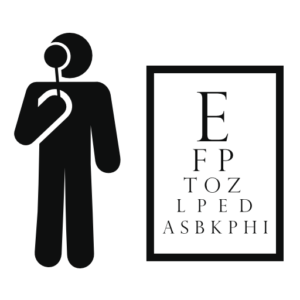This PDF covers any alteration in vision, such as blurriness, seeing double, flashing lights or floating spots, and losing some or all of your field of vision. To rule out the chance of an eye disorder that could endanger your vision, you should notify your doctor right away if you notice any such change in your vision. Many of these problems may only be successfully treated if the condition is discovered early on.
EYE TESTING
After the age of 40, you should have your eyes checked every two years. Your ability to read the letters on a Snellen chart will be tested by the optometrist. The test’s outcome is shown as two figures. The first one refers to the reading distance in meters, which is typically 6m (approximately 20 ft). The second figure is the maximum distance in meters at which a person with normal vision could read the lowest row of letters that you were able to read correctly. The result 6/12 indicates that the lowest row of letters you could read at a distance of 6 meters is the same row that a person with normal vision could read at a distance of 12 meters. The optometrist will also inspect the eye to check for any symptoms of a general illness, such as diabetes or high blood pressure. Additionally, he or she will assess how well the muscles that manage eye movement are balanced.
COLOR BLINDNESS
The inability to discern between certain colors due to a hereditary condition is known as color blindness. Red, green, and blue are the primary colors of light rays that enter your eyes, and they are the building elements from which all other colors are created. Rarely does someone have true color blindness, in which case everything seems to be grayscale. The most prevalent flaw, which mostly affects men, is the inability to tell the difference between red and green. The majority of people adapt to this little impairment without any issues. A comprehensive eye examination, which includes tests for color vision, will be required of anyone applying for a job requiring excellent color vision, such as that of an airline pilot.
CONTACT LENSES
As an alternative to glasses, many people use contact lenses. Although hard plastic lenses are strong, affordable, and provide clear vision, many people find them uncomfortable. Although less durable and more expensive, hard, gas-permeable lenses are more comfortable because they let oxygen enter the eyes. Although more brittle than hard lenses, soft lenses are more comfortable. Selecting the kind of lens that is most appropriate for you will be advised by your ophthalmologist.
Contact lens maintenance
To eliminate debris and stop the accumulation of protein deposits on the lens, all forms of contact lenses require routine, careful cleaning. There is a risk of infection and long-term eye damage if this is not done. Always follow your optometrist’s instructions for lens care precisely and use the particular cleaning and soaking solutions that have been recommended for your lenses.


